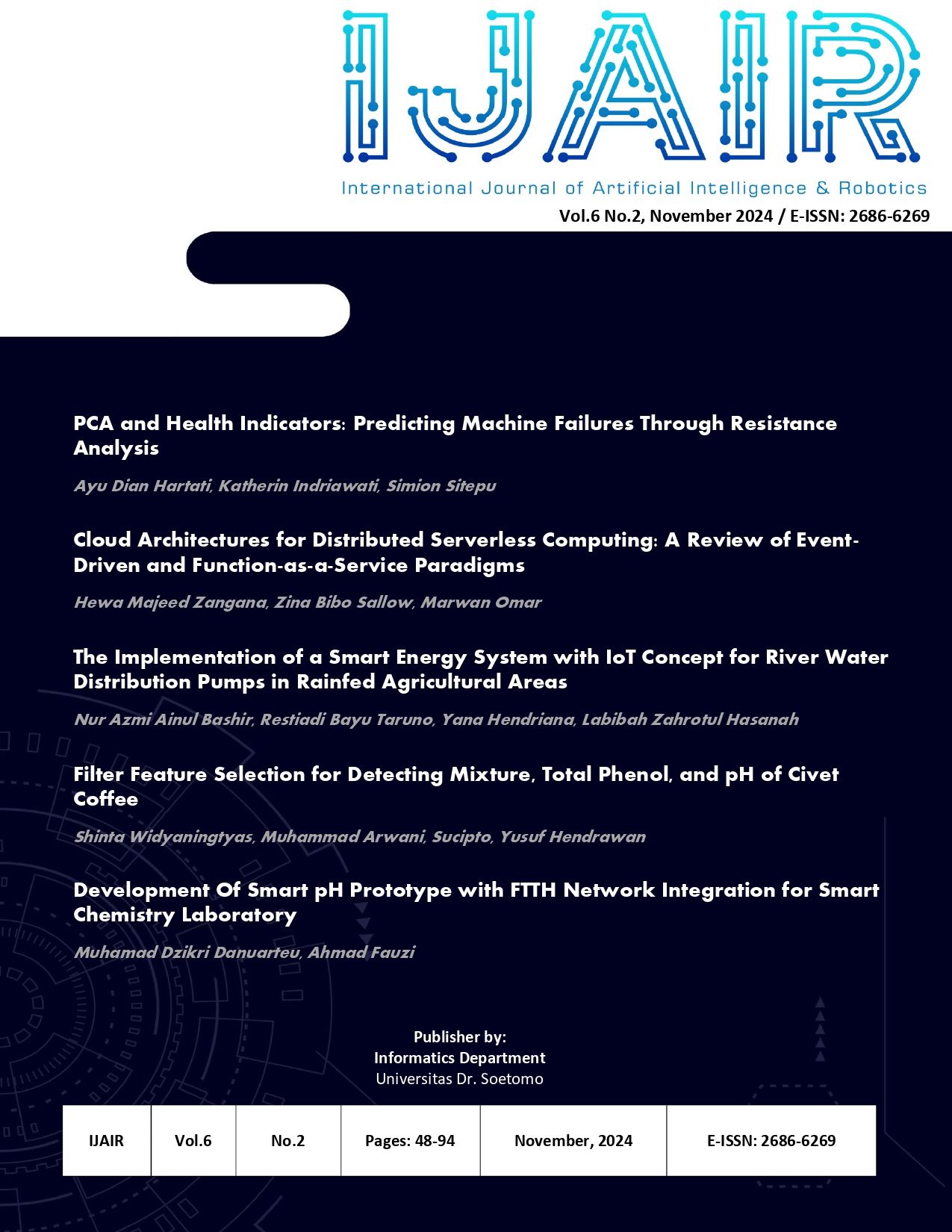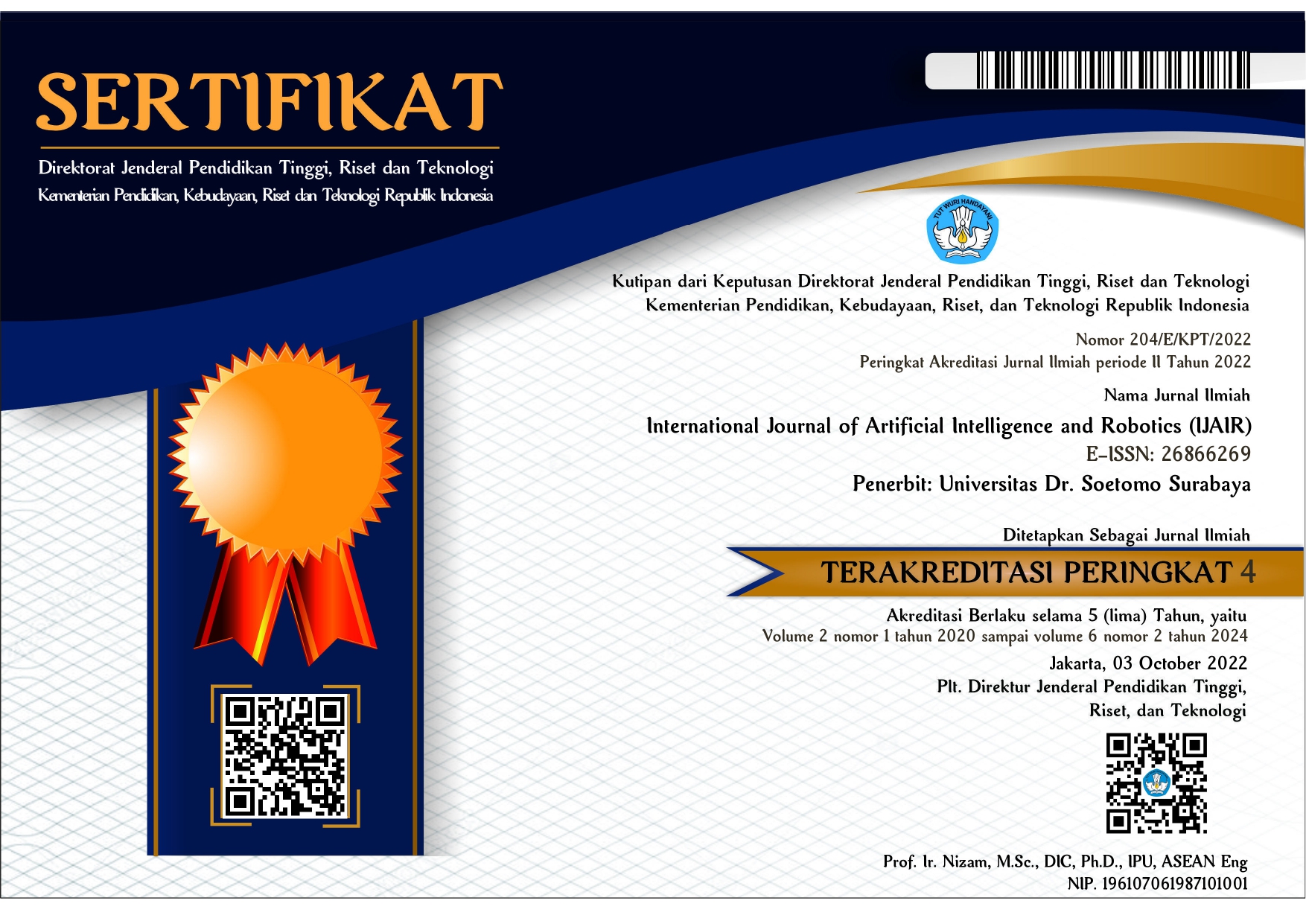The Implementation of a Smart Energy System with IoT Concept for River Water Distribution Pumps in Rainfed Agricultural Areas
 Abstract views: 189
,
Abstract views: 189
,
 PDF downloads: 139
PDF downloads: 139
Abstract
Water pumps for irrigating rainfed rice fields are typically located near or at the edge of rivers, for example, in several locations in Bulakelor and Luwunggede, Brebes Regency villages. Similar situations are found in some rice fields in Sendangadi, Mlati, Sleman, and Piyungan, Bantul, where irrigation pumps are near or at the edge of rivers. According to residents, this reduces the suction power needed. Unfortunately, this also affects the terrain, making it damp and the roads muddy and even slippery, which makes the journey to the pump location difficult and risky, like slipping into a river when the ground is wet and slippery. There is a need to solve this problem by creating an automated pump system that implements IoT concepts using microcontrollers and other control components. The manual water pump is replaced with an electric pump to simplify operation. Control is carried out remotely using a mobile application accessible via websites or smartphones, allowing users to monitor pump operations such as usage duration, automatic on/off scheduling, pump status, and more. This reduces the risk of work accidents with the conventional system. A Renewable Energy System (RES) using a solar power plant (PLTS) is also applied to anticipate power outages, ensuring the IoT system continues to operate and irrigation remains manageable. The operation of such pumps still uses conventional methods that require direct human labor, and only specific individuals can operate the pumps. One example is using diesel pumps that are started by cranking, which requires significant physical strength. These pumps are typically managed collectively by the residents, who take turns operating the pump. Another factor is the age of the pump engine itself, which affects its lifespan. The usage is often not well controlled, with uncertainty in the operating times and operator negligence, such as forgetting to turn off the pump. The limitation of this research is that the operation is conducted automatically based on previous pump usage data, ignoring the size of the pipes used in irrigation and focusing on simplifying the operation of the water pump. The system was installed in rainfed fields in Pagergunung hamlet, where farmers used it to operate water pumps via smartphones with the Ubidots application installed and logged in. The results showed that two farmer groups found the automated pump system helpful. The system was built with several components, including the ESP8266 microcontroller, a rain sensor, a relay/power switch, and other supporting components. The system operates automatically according to the morning operational schedule, and operators from each farmer group can control the pump remotely. The pump operates automatically at 6:00 AM, 6:30 AM, and 7:00 AM. If the rain sensor does not detect water drops/rain, the pump will typically run for 1.5 hours. The innovation in this research lies in implementing an automated pump system that operates according to a schedule while allowing remote control of the pump to irrigate rainfed fields.
Downloads
References
Padang Pariaman Distankp, “Padi Tadah Hujan dan Berumur Genjah,†Dinas Pertanian dan Ketahanan Pangan. Accessed: Mar. 29, 2024. [Online]. Available: https://distankp.padangpariamankab.go.id/home/posting/Padi-Tadah-Hujan-dan-Berumur-Genjah
Dinpertanpangan Demak Kab, “Teknologi Budidaya Padi Sawah Tadah Hujan,†Dinas Pertanian dan Pangan Kabupaten Demak.
R. B. Taruno, I. Unggara, J. Ipmawati, Y. Hendriana, N. A. A. Bashir, and Z. Zulkhairi, “Pemanfaatan Energi Baru Terbarukan Smart Farming System dalam Peningkatan Hasil Pertanian dan Perikanan,†Berdikari: Jurnal Inovasi dan Penerapan Ipteks, vol. 11, no. 1, Apr. 2023, doi: 10.18196/berdikari.v11i1.16972.
Y. Hendriana, R. Bayu Taruno, N. Azmi Ainul Bashir, J. Ipmawati, and I. Unggara, "Water Quality Monitoring for Smart Farming Using Machine Learning Approach," vol. 5, no. 2, pp. 81–90, 2023.
Asepta Surya Wardhana, A. Ayende, P. Pujianto, Roni Heru Triyanto, and Astrie Kusuma Dewi, “Pemanfaatan Panel Surya Untuk Pompa Irigasi Tanaman di Area Perhutani Jatirejo Cepu,†ABDIKAN: Jurnal Pengabdian Masyarakat Bidang Sains dan Teknologi, vol. 2, no. 4, pp. 547–557, Nov. 2023, doi: 10.55123/abdikan.v2i4.2691.
H. H. Sinaga, D. Permata, N. Soedjarwanto, and N. Purwasih, “Pompa Air Tenaga Surya untuk Irigasi Persawahan bagi Masyarakat Desa Karang Rejo, Pesawaran, Lampung,†Wikrama Parahita : Jurnal Pengabdian Masyarakat, vol. 5, no. 1, pp. 22–26, Mar. 2021, doi: 10.30656/jpmwp.v5i1.2633.
R. N. Rohmah, A. Supardi, B. Handaga, H. Supriyono, and A. Mulyaningtyas, “PENERAPAN ALAT PENGENDALI SEMI-OTOMASI POMPA AIR PADA SISTEM PENGAIRAN SAWAH TADAH HUJAN DI DESA WONOREJOâ€.
L. Jacobus, E. Setyowati, E. N. S. Patty, and F. Bokol, “Desain Sistem Pompa Air Tenaga Surya,†Elektriese: Jurnal Sains dan Teknologi Elektro, vol. 13, no. 01, pp. 1–8, May 2023, doi: 10.47709/elektriese.v13i01.2283.
R. Rizki Ramadhan and K. Kunci -Kelembaban Tanah, “Simulasi Sistem Penyiraman Tanaman Otomatis Menggunakan Sensor Kelembaban tanah dan Sensor Suhu Berbasis Arduino,†in SinarFe7: Seminar Nasional Fortei Regional 7, 2021, pp. 396–401.
S. R. Auliany, T. Dw Lumbantoruan, M. Rusdi, T. Telekomunikasi, T. Elektro, and P. N. Medan, “Rancang Bangun Penyiram Tanaman Otomatis Menggunakan Timer Dengan Sensor YL-69 Berbasis Internet Of Things (IOT)â€.
P. Jaya Prakash Reddy, G. Viswanadh, and S. Kumar Singh, "IOT based Smart Water Pump Switch," in 2021 2nd International Conference on Intelligent Engineering and Management (ICIEM), IEEE, Apr. 2021, pp. 534–538. doi: 10.1109/ICIEM51511.2021.9445278.
D. Batham, K. Singh Rajput, D. Singh Sikarwar, S. Jain, A. Mukharya, and K. Sabre, "AI-Based Motor/Water Pump Switching System," in International Conference for Undergraduate Students 2021 (ICUS-2021), 2021, pp. 1–5.
A. Widodo and A. Sumaedi, “Prototipe Deteksi Hujan Berbasis Arduino Uno Menggunakan Rain Drop Sensor Module,†Jurnal Informatika STMIK Antar Bangsa, vol. 9, no. 1, pp. 18–24, 2023.
Y. Hendriana, R. B. Taruno, Z. Zulkhairi, N. A. A. Bashir, J. Ipmawati, and I. Unggara, “Water Quality Monitoring for Smart Farming Using Machine Learning Approach,†International Journal of Artificial Intelligence & Robotics (IJAIR), vol. 5, no. 2, pp. 81–90, Dec. 2023, doi: 10.25139/ijair.v5i2.7499.
N. D. S. D. E. S. Nur Fauziah, “Perancangan Alat Pengendali Air Berbasi IoT,†JUPITER: Publikasi Ilmu Keteknikan Industri, Teknik Elektro, dan Informatika, vol. 1, no. 6, pp. 36–41, Nov. 2023.
A. Burlian and C. Bella, “Rancang Bangun Penjadwalan Otomatis Pemberian Air Pada Akuaponik Berbasis Arduino Uno R3.â€
Zikrilla et al., “Otomatisasi Sistem Irigasi Pada Tanaman Cabai Berbasis Arduino Dengan Parameter Kelembaban Tanah,†in Seminar Nasional Terapan Riset Inovatif (SENTRINOV), 2021, pp. 301–308. Accessed: Jun. 22, 2024.
M. W. A. Aly Sayyed, "Towards an Autonomous and Smart Water Tank System," International Journal of Emerging Trends in Engineering Research, vol. 9, no. 3, pp. 240–244, Mar. 2021, doi: 10.30534/ijeter/2021/15932021.
Md. N. Alam, A. Shufian, Md. A. Al Masum, and A. Al Noman, "Efficient Smart Water Management System Using IoT Technology," in 2021 International Conference on Automation, Control and Mechatronics for Industry 4.0 (ACMI), IEEE, Jul. 2021, pp. 1–6. doi: 10.1109/ACMI53878.2021.9528202.
M. S. Pandang, N. Nachrowie, and R. D. J. K. Sari, "Prototype Kendali Arus dan Tegangan Menggunakan Internet of Things (IoT)," Blend Sains Jurnal Teknik, vol. 2, no. 2, pp. 191–197, Oct. 2023, doi: 10.56211/blendsains.v2i2.351.
Muhammad Fikri Setiadi, Muhammad Radzi Rathomi, and Nurfalinda, “Rancang Bangun Aplikasi Sistem Monitoring Deteksi Hujan Berbasis Maps Dan IOT,†Skripsi, Universitas Maritim Raja Ali Haji, Tanjungpinang, 2023.
R. Amalianti, A. Jabbar Lubis, and I. Lubis, “Rancang Bangun Miniatur Stasiun Cuaca Untuk Monitoring Curah Hujan, Suhu Dan Kelembaban Udara Area Lokal Menggunakan Berbasis IOT,†in Prosiding SNASTIKOM: Seminar Nasional Teknologi Informasi & Komunikasi, 2021, pp. 241–247.
R. Daniel, "Rancang Bangun Alat Monitoring Kelembaban, PH Tanah dan Pompa Otomatis Berbasis Arduino," Journal of Applied Computer Science and Technology, vol. 3, no. 2, pp. 208–212, Dec. 2022, doi: 10.52158/jacost.v3i2.384.
M. Rouzikin Annur, N. Hidayat, and A. A. Soebroto, “Implementasi Deteksi Hujan dan Banjir Secara Real Time Monitoring berbasis MQTT Over Websocket Menggunakan Modul ESP8266,†2021.
N. Fauza, “Rancang Bangun Prototipe Detektor Hujan Sederhana Berbasis Raindrop Sensor Menggunakan Buzzer Dan LED,†Jurnal Kumparan Fisika, vol. 4, no. 3, pp. 163–168, Dec. 2021, doi: 10.33369/jkf.4.3.163-168.
I. Gusti Pranata Sembiring and A. A. Ritonga, “Pemanfaatan Panel Surya Untuk Pompa Air Dengan Tenaga Matahari,†Pemanfaatan Panel Surya (Iqbal, dkk.) Madani: Jurnal Ilmiah Multidisiplin, vol. 2, no. 2, pp. 165–171, 2024, doi: 10.5281/zenodo.10895553.
Rendytama Fito Bahari, Ramadhani Firmansyah, and Ninik Martini, “Optimalisasi Pembangkit Listrik Energi Matahari sebagai Penggerak Pompa Air dengan Menggunakan Panel Surya,†Publikasi Online Mahasiswa Teknik Mesin, vol. 4, no. 2, pp. 1–10, Nov. 2022.
Copyright (c) 2024 Nur Azmi Ainul Bashir, Restiadi Bayu Taruno, Yana Hendriana, Labibah Zahrotul Hasanah

This work is licensed under a Creative Commons Attribution-ShareAlike 4.0 International License.
Authors who publish with International Journal of Artificial Intelligence & Robotics (IJAIR) agree to the following terms:
-
Authors retain copyright and grant the journal right of first publication with the work simultaneously licensed under a Creative Commons Attribution License (CC BY-SA 4.0) that allows others to share the work with an acknowledgment of the work's authorship and initial publication in this journal.
-
Authors are able to enter into separate, additional contractual arrangements for the non-exclusive distribution of the journal's published version of the work (e.g., post it to an institutional repository or publish it in a book), with an acknowledgment of its initial publication in this journal.
-
Authors are permitted and encouraged to post their work online (e.g., in institutional repositories or on their website) prior to and during the submission process, as it can lead to productive exchanges, as well as earlier and greater citation of published work.















